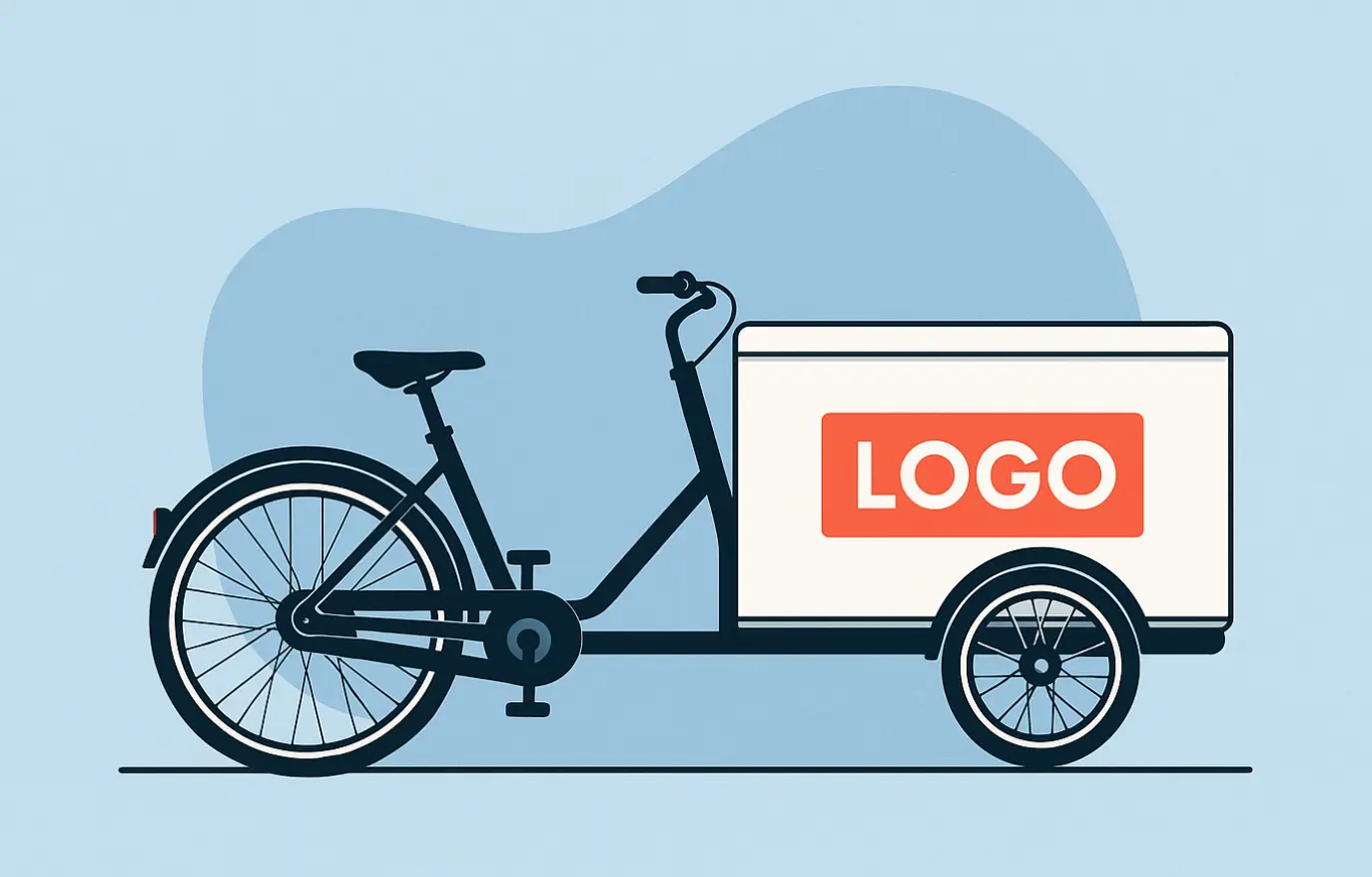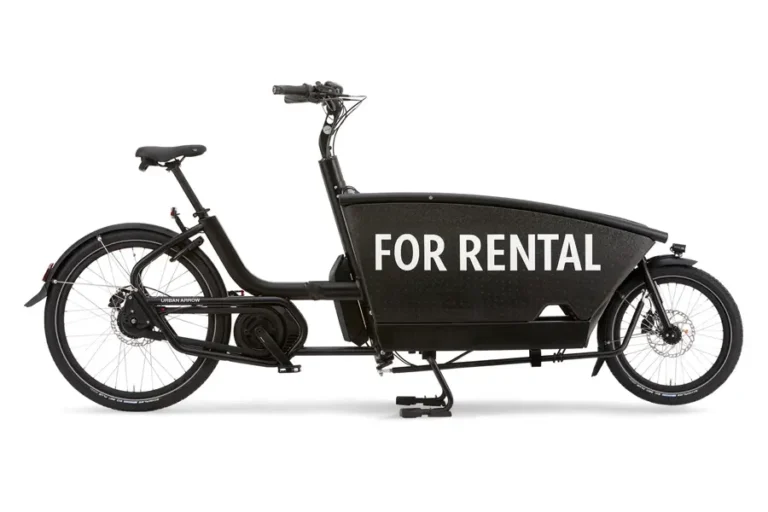Linnalogistikas on kaubarattad rohkem kui lihtsalt transpordilahendus - see on liikuv reklaamtahvel. Meie Regen-s usume, et kaubakast on kõige nähtavam ja interaktiivsem komponent mis tahes kaubaratta puhul. See on koht, kus disain kohtub funktsiooniga ja kus kaubamärk kohtub publikuga.
Erinevalt traditsioonilisest reklaamist, mis nõuab sageli pidevat meediaostu ja piiratud sihtotstarbelist reklaami, pakuvad kohandatud kaubakastid odav, suure sagedusega brändi loomise võimalus mis integreerub sujuvalt igapäevastesse toimingutesse. Olenemata sellest, kas seda kasutatakse kohalikes tarnetes, mobiilses jaemüügis või brändi aktiveerimisel, on teie kaubakast pidevalt kokkupuutes jalakäijate, autojuhtide ja potentsiaalsete klientidega.
Miks Cargo Box paistab silma
Lastikast on iga kaubaratta kõige nähtavam osa. Selle suured, tasased pinnad pakuvad suurepärase võimaluse reklaamiks, lugude jutustamiseks ja brändi tutvustamiseks - ja seda palju odavamalt kui traditsioonilised reklaamplakatid. Kui seda tehakse õigesti, ei kanna kohandatud kastid mitte ainult kaupa, vaid ka identiteeti, väärtusi ja tunnustust.
- Suur pindala: Kaubakast moodustab tavaliselt kaubaratta suurima visuaalse pinna. Kohandatud kujul muutub see ruum silmatorkavaks, hästi nähtavaks kaubamärgikandjaks.
- Avalikkuse lähedus: Kaubarattad töötavad tänava tasandil, sageli jalgrattateedel, kõnniteedel ja tiheda liiklusega platsidel - piisavalt lähedal, et inimesed saaksid lugeda teie loosungit, skaneerida QR-koodi või ära tunda teie värvid.
- Liikuvus + kordamine: Regulaarsed kohalikud tarneteed muudavad teie jalgratta jooksev reklaam, tugevdades oma sõnumit iga päev samades linnaosades.
- Mitmeotstarbeline väärtus: Erinevalt paberkandjal flaieritest või digitaalsetest muljetest pakub kaubamärgiga varustatud kaubakast kahesugust väärtust - transpordifunktsionaalsust ja järjepidevat kaubamärgiga kokkupuudet.
Ühendkuningriigi Jalgratturite Liidu 2023. aasta uuringu kohaselt on linnatarbijatel 3,5 korda suurem tõenäosus jätta meelde kaubamärk, mida nad näevad kaubamärgiga varustatud jalgrattal, kui reklaamplakatil, kuna jalgratas on linnas silmapiiril ja uudsuse faktor.
Kaubakasti kohandamise tüübid
| Tüüp | Kirjeldus | Kasutusjuhtum | Peamised omadused |
|---|---|---|---|
| Visuaalne kohandamine | Keskendub visuaalsele identiteedile ja kaubamärgile | Linnatarned, brändi aktiveerimine | Brändi värvid, logo paigutus, tüpograafia |
| Struktuuri kohandamine | Muudab kasti kuju või juurdepääsumehhanismi | Mobiilne müügimüük, ürituse turundus | Lükanduksed, riiulid, ebakorrapärased vormid |
| Funktsionaalne kohandamine | Lisab kasulikke või tulemuslikkust suurendavaid funktsioone | Toiduainete kohaletoimetamine, postiteenused, külmkett | Isolatsioon, valgustus, modulaarne ladustamine |
Reaalsed näited kaubamärgiga kaubakastide kohta
oleme omal nahal näinud, kuidas ettevõtted kasutavad kaubakastide kohandamist mitte ainult esteetilisuse eesmärgil, vaid ka meeldejääva, suure mõjuga brändingu loomiseks. Siin on mõned reaalsed näited sellest, kuidas tuntud kaubamärgid on integreerinud kaubakastide disaini oma äri- ja turundusstrateegiasse:
1. DHL Cubicycle (Madalmaad)
- Kohandamise tüüp: Visuaalne + funktsionaalne
- Tähtsündmused: Cubicycle on disainitud DHL-i kollases toonis ja sellel on modulaarne, aerodünaamiline kaubakast, millel on ülisuur logod ja puhtad, minimalistlikud jooned.
- Mõju: Need jalgrattad tugevdavad DHL-i pühendumust kaasaegsele, keskkonnasõbralikule logistikale, olles samal ajal maanteel koheselt äratuntavad. Juba ainuüksi värvist piisab, et tekitada brändi meeldejäämine.
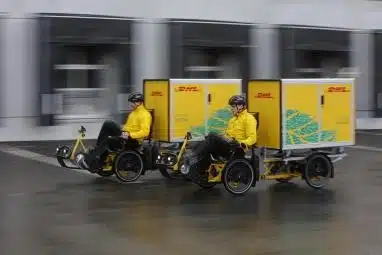
3. Urban Arrow x Zoomo
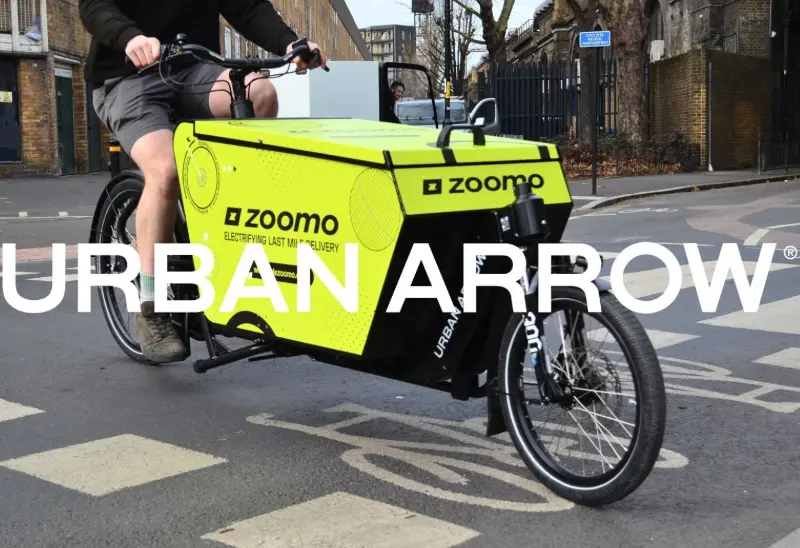
- Kohandamise tüüp: Visuaalne + funktsionaalne
- Tähtsündmused: See Urban Arrow ja Zoomo ühismärgiga heleroheline kaubakast sisaldab laevastiku jälgimise siltide ja tugevate mooduliliste sektsioonidena "Zoomo" märgistust ning on mõeldud tellimuslaevastike jaoks.
- Mõju: Tugevdab ühtset laevastiku identiteeti, mis on kättesaadav Zoomo platvormi kaudu, tutvustades äriklientide jaoks skaleeritavat business-as-a-service mudelit.
4. TIER Mobility Cargo eBikes (Saksamaa, Skandinaavia)
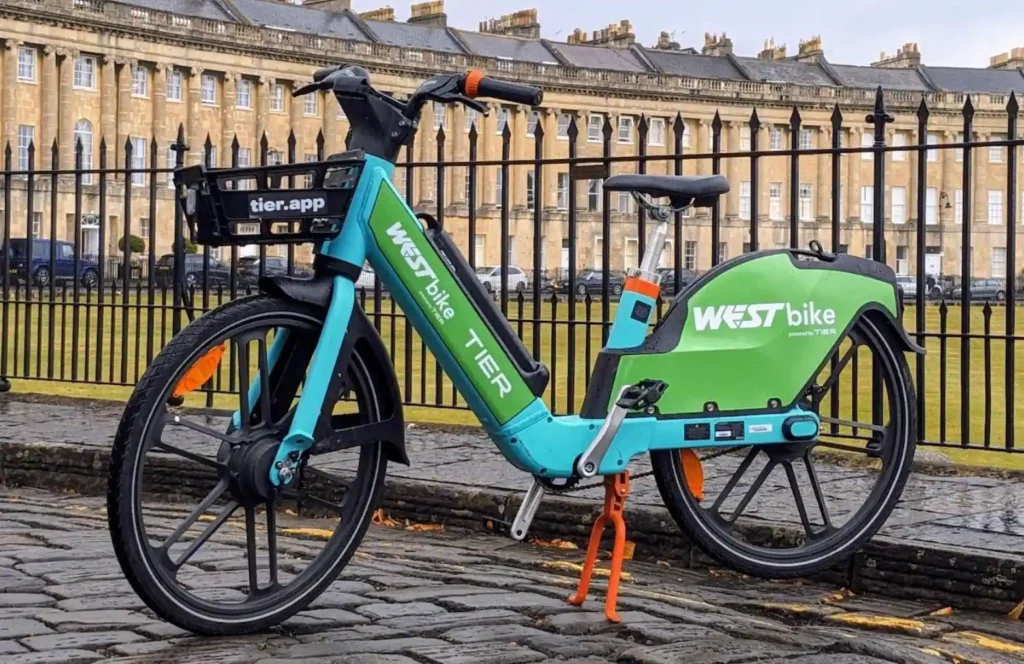
- Kohandamise tüüp: Visuaalne + funktsionaalne
- Tähtsündmused: Mis sisaldab heleroheline värviskeem, puhas tüpograafia ja integreeritud GPS/IoT andurid laevastiku jälgimiseks ja tegevuse tõhususe tagamiseks.
- Mõju: Teavitab läbipaistvust, tehnoloogilist innovatsiooni ja pühendumust puhtale transpordile - see on oluline, et ühistransporditeenused saavutaksid üldsuse usalduse.
5. Coolblue eCargo Bikes (Holland)
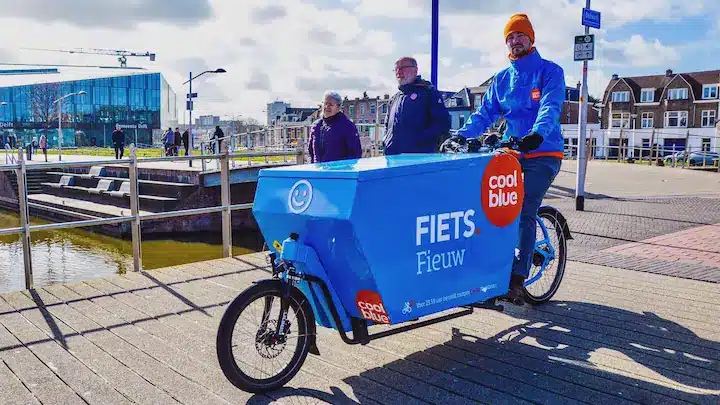
- Kohandamise tüüp: Visuaalne + struktuuriline
- Tähtsündmused: Sügavsinised kaubakastid valge "Coolblue" tekstiga ja kergete loosungitega nagu "Täna on tarnepäev!". Karbis on sageli integreeritud riiulisüsteem habras elektroonika jaoks.
- Mõju: Suhtleb sõbralikkust ja tehnikahuvilist teenindust. Sõnumid ja struktuur aitavad klientidel brändiga emotsionaalselt sidet luua, eriti ukselähedase kättetoimetamise ajal.
Kas soovite uurida, kuidas ettevõtted kogu Euroopas kasutavad kaubarattaid tegelikus logistikas, tarnetes ja turunduses?
Viis põhimõtet efektiivse kaubakasti brändingu jaoks
Kuidas muuta oma kaubakast võimsaks brändi varaks
Teie kaubaratta kasti kohandamine ei tähenda mitte ainult head välimust, vaid ka vastupidava, funktsionaalse ja meeldejääva brändikogemuse loomist. Veebilehel Regen, aitame klientidel ehitada kaubakaste, mis ei kanna mitte ainult tooteid - nad kannavad brändi väärtused. Allpool on viis olulist põhimõtet, mida me järgime, et tagada iga kasti maksimaalne mõju.
| Põhimõte | Mida see tähendab | Kuidas seda rakendada |
|---|---|---|
| Värvi järjepidevus | Kasutage brändi värvi(d) täpselt | Sobitatakse RAL/Pantone toonidega, kasutatakse matti või peegeldusvastast katet. |
| Logo selgus | Suured ja loetavad logod kõikidel külgedel | Eelistage kõrge kontrasti paigutust |
| Eesmärgi sobitamine | Funktsioonile sobiv disain | Kasutage vajaduse korral toiduainekindlaid vooderdisi, veekindlaid materjale. |
| Modulaarne disain | Paindlik funktsionaalsus | Võimaldab kiireid vahetusi kastitüüpide vahel (nt külm, kuiv, pakett). |
| Hooldussõbralikkus | Vastupidav ja kergesti puhastatav | Valige UV-stabiilsed vinüülkatted, kriimustusvastased pinnakatted |
1. Värvi järjepidevus
Mida see tähendab: Teie brändi värvid on osa selle identiteedist - nagu ka logo või tunnuslause. Kuid väliskeskkond ja karm valgustus võivad värve moonutada, kui materjale ei valita hoolikalt.
Kuidas seda rakendada:
- Vastab täpselt RAL- või Pantone-värvistandarditele.
- Kasutamine matt või peegeldusvastane viimistlus et vältida peegeldusi päikesevalguses.
- Vältige liiga läikivaid kattematerjale, mis võivad UV-kiirguse mõjul tuhmuda või kooruda.
- Näide: DHLi Cubicycles säilitavad oma ikoonilise kollase värvuse ka pärast kuud kestnud tänaval viibimist tänu
2. Logo selgus
Mida see tähendab: Teie logo peaks olema kohe nähtav ja loetav mitme nurga alt - eest, küljelt ja tagant.
Kuidas seda rakendada:
- Kasutamine suured, suure kontrastsusega logod maksimaalse loetavuse tagamiseks.
- Vältige logode paigutamist hingede, sulgurite või ebatasaste pindade kohale.
- Peegeldav vinüül või taustavalgustusega logod võivad parandada nähtavust öösel.
- Näide: Domino's kasutab julgeid punaseid ja siniseid logosid isoleeritud tarnekastidel, millel on sisseehitatud tuled öösel nähtavuse tagamiseks.
3. Eesmärgi sobitamine
Mida see tähendab: Kujundus peaks toetama kasti tegelikku kasutust - olgu see siis toit, pakendid või reklaammaterjalid.
Kuidas seda rakendada:
- Kasutamine isoleeritud vooder sooja või külma toidu kohaletoimetamiseks.
- Lisa veekindlad tihendid vihmase kliima jaoks.
- Lisage ventilatsioonipaneelid toodete jaoks, mis vajavad õhuvoolu.
- Näide: Picnic'i lihtsad, toiduainetele ohutud kaubakastid peegeldavad nende keskendumist toidukaupade värskusele ja peresõbralikule kohaletoimetamisele.
4. Modulaarne disain
Mida see tähendab: Kaubakastid peaksid olema kohandatavad - eriti muutuvate vajadustega või hooajaliste teenustega ettevõtete jaoks.
Kuidas seda rakendada:
- Kujunduskarbid, mida saab vahetada külma ahela ja kuiva tarne konfiguratsiooni vahel.
- Kaasa universaalsed kinnitusklambrid või modulaarsed sisestused.
- Ehitage kastid, mida saab kiiresti eemaldada või asendada.
- Näide: Urban Arrow x Zoomo jalgrattad on ehitatud modulaarse logistikaga, mis teenindab mitut liiki ettevõtteid ühes autopargis.
5. Hooldussõbralikkus
Mida see tähendab: Puhas kast on usaldusväärne kast. Määrdunud, kriimustatud või koorunud pinnad kahjustavad kaubamärgi tajumist.
Kuidas seda rakendada:
- Näide: TIER Mobility jagatud eCargo autopargis kasutatakse vastupidavat viimistlust, mis peab vastu tihedas kasutuses ja avalikkuse ees.
- Kasutamine UV-stabiilsed vinüülkatted mis seisavad vastu pleekimisele ja päikesekahjustustele.
- Valige materjalid, mille kriimustusvastased ja kergesti puhastatavad katted.
- Vältige tekstuurseid pindu, mis kinnitavad mustust või niiskust.
Tahad uurida, milline võiks olla sinu enda kaubamärgiga kaubakast? Võtke ühendust meie meeskonnaga tasuta konsultatsiooni saamiseks.
Võta meiega ühendust
Ehitame sulle kaubaratta.
- Rua Alto do Vale do Grou 231, 3750-064 Águeda
- +1 6377391888
- info@regencargobikes.com
Bränditud kaubakastide kohandamise töövoog - Regen tööprotsess
Kohandatud kaubakasti loomine ei tähenda ainult logo küljele panemist. Regen järgib selget ja koostööpõhist protsessi, et muuta teie brändiideed vastupidavaks, täielikult toimivaks ja pilkupüüdvaks kastiks, mis töötab reaalses maailmas.
Siin on, kuidas meie seitsmeastmeline kohandamise tööprotsess töötab:
1. Määratlege kasutusjuhtum
Küsige: Mis on selle kasti peamine ülesanne?
Kas see on mõeldud igapäevaseks viimase miili tarne, reklaamikampaaniate, mobiilse jaemüügi või ürituste aktiveerimiseks? Kavandatav kasutusviis mõjutab kõiki disaini aspekte - alates struktuurist kuni materjalideni.
- Kohaletoimetamine: Esmatähtsad on isolatsioon, lukustatavad ruumid ja ilmastikukindlus.
- Edendamine: Maksimeerida nähtavust, lisada valgustus või isegi interaktiivsed ekraanid.
- Müük/ürituste kasutamine: Kaaluge modulaarseid riiuleid, POS-integratsiooni või vaateaknaid.
2. Brändi varade kogumine
Koguge kokku kõik elemendid, mis esindavad teie identiteeti.
Me palume teie kõrgresolutsiooniga logo failid, brändi värvi spetsifikatsioonid (RAL/Pantone), tüpograafia stiilid ja tootevisuaalid. Mida täpsemad ja ühtsemad on teie varad, seda tugevam on lõplik disain.
💡 Pro nõuanne: esitage ka kampaania loosungid või QR-koodid, kui soovite, et need oleksid integreeritud kasti kujundusse.
3. Valige kasti tüüp
Valige oma funktsioonile ja kuvandile sobiv struktuur.
Pakume erinevaid vormifaktoreid, mis sobivad erinevatele kasutusviisidele:
- Standardsed ristkülikukujulised kastid: Ideaalne mahupõhiseks tarnimiseks.
- Pikad John-stiilis eesmised laadijad: Elegantne ja mitmekülgne, sobib ideaalselt linnalogistikasse.
- Kõverad või asümmeetrilised kastid: Suurepärane kaubamärkide jaoks, mis soovivad eristuda ebatraditsioonilise esteetikaga.
4. Lisage nutikaid funktsioone
Funktsionaalsus ja innovatsioon.
Saate valida mitmesuguste lisade vahel, sõltuvalt teie tegevusvajadustest ja turunduseesmärkidest:
- LED sise- või välisvalgustus valgustus öine nähtavus
- Isolatsioonikihid toidu või meditsiinilise logistika jaoks
- Vaheseinad või vaheseinad esemete eraldamiseks
- Päikesepaneelid passiivne energia (nt tuled, laadimisjaamad)
Näide: Üks toidutarne klient lisas lastikasti sisse küttepaneeli ja varuaku.
5. Valige õiged materjalid
Tasakaalustage vastupidavus, kaal ja esteetika.
Meie inseneriteaduskond aitab teil valida testitud materjalide hulgast:
- Alumiinium: Kerge, korrosioonikindel, tööstuslik välimus
- Polüpropüleen (PP): Taaskasutatav, vastupidav, kuluefektiivne
- Vineer: Looduslik välimus, ideaalne pop-up kaupluste ja jaemüügi jaoks.
- Komposiitpaneelid: Suurepärane isolatsioon ja struktuur ühes
- Läbipaistvad paneelid: Läbipaistvate väljapanekukastide jaoks
🎯 Materjalide valikul arvestame alati kaalujaotust ja löögikindlust.
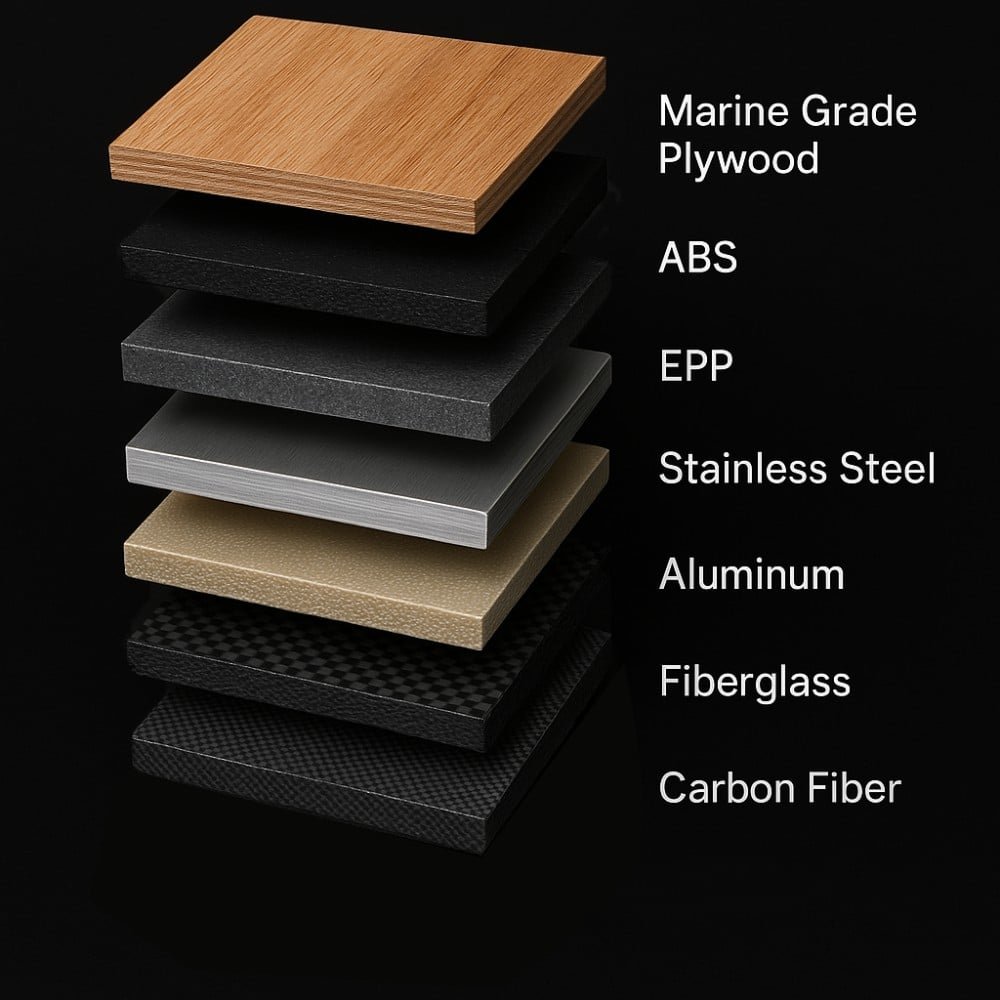
6. Prototüübi ehitamine ja testimine
Valideerige enne skaalumist.
Enne masstootmist töötame välja täieliku prototüübi:
- Testid trükikvaliteet ja kleepuvus kumeratel pindadel
- Nähtavuse kontroll erinevate nurkade ja valgustingimuste juures
- Struktuuri stabiilsus tegelikes koormustingimustes
- Vabatahtlik: Välitööd kasutajate reaktsioonide või tarnimise tulemuslikkuse testimiseks.
✅ Saate fotod, füüsilise näidise (kui vaja) ja tehnilised aruanded.
7. Masstootmine ja kvaliteedikontroll
Mastaapsus ilma kvaliteeti ohverdamata.
Kui prototüüp on heaks kiidetud, läheme üle hulgi tootmisele:
- Täielik värvikalibreerimine, et kõik seadmed vastaksid brändi standarditele
- Materjalide ja koostu kvaliteedikontroll vastupidavuse tagamiseks
- Valikuline üksikute üksuste vöötkoodimine või jälgimissildid
- Logistika planeerimine (me tarnime nii ELi kui ka Hiina rajatistest)
📦 Tarneaeg on tavaliselt 15-60 päeva, sõltuvalt mahust ja omadustest.
Üldised küsimused kaubakasti märgistamise kohta
Regen inseneri- ja disainimeeskonna kiired vastused
K1: Kas graafilist pakendit saab hõlpsasti vahetada kampaaniate jaoks?
A1: Jah. Paljud kaubamärgid kasutavad eemaldatavad vinüülkatted või magnetilised külgpaneelid kampaania kiireks uuendamiseks. See võimaldab hooajaline bränding, ürituste reklaamiüritusedvõi co-branding ilma kogu kasti ümber ehitamata. Regen pakub nii püsivaid kui ka ajutisi pakkimislahendusi, mis põhinevad teie tegevusvajadustel.
K2: Kas kohandatud kast ohustab jalgratta nõuetele vastavust?
A2: Et jääda seaduslikuks ja ohutuks, peavad kastid järgima selliseid standardeid nagu EN 17860 (kaubaratta ohutus) ja kohalikud laiuse/kaalu piirangud. Liiga lai, kõrge või raske kast võib mõjutada tasakaal, pidurdamine või nähtavus. Regen tagab, et kõik kohandatud disainilahendused jäävad nõuetele vastavaks ja liiklusohutuks.
3. küsimus: Milline on parim tarnija kohandatud kaubakastide jaoks?
A3: Töötage koos kogenud kaubaratta tootjad või ODM/projekteerimise tarnijad kes mõistavad nii brändingut kui ka funktsionaalsust. Otsige partnereid, kes pakuvad integreeritud teenused: visuaalne disain, konstruktsioonitehnika, materjalide katsetamine ja masstootmine. Regen pakub kõike seda ühe katuse all.
K4: Kas ma saan kohandada nii kasti kui ka jalgratta raami?
A4: Jah. Täielikult kaubamärgiga laevastiku puhul kohandavad paljud kliendid nii kaubakast ja jalgratta raami värv, kahvel ja ketikaitse. Toetame kogu laevastiku brändingut koos raami pulbervärvimine, kleebiste integreerimineja istme või kaitseraua värvi sobitamine taotluse korral.
K5: Kui ilmastikukindlad on kohandatud pakendid või kastide pinnad?
A5: Meie pakendid on trükitud UV-kindel vinüül, koos valikulise kriimustusvastane lamineerimine kaitsta vihma, lume, päikese ja kulumise eest. Sellised materjalid nagu alumiiniumkomposiit ka veekahjustuste vastu. Nõuetekohane hooldus tagab 2-4 aastat kestva vastupidavuse linnakeskkonnas.
K6: Kas ma saan taotleda ka sisemist kohandamist (nt sektsioonid, isolatsioon)?
A6: Absoluutselt. Paljud logistikakliendid vajavad selliseid sisemisi funktsioone nagu:
- Isoleeritud vooder toidu/sooja tarne puhul
- vahtpolüstri või vaheseinad õrnade kaupade puhul
- LED-valgustus öösel toimuvaks kohaletoimetamiseks
- asjade interneti jälgimismoodulid või USB toide
Regen võib aidata neid funktsioone integreerida otse karbi valmistamise ajal.
K7: Kui kiiresti saan kohandatud kaubakasti?
A7: Tüüpilised tähtajad:
- Kontseptsioon ja disain: 7-10 päeva
- Prototüüp: 10-20 päeva (koos testimisega)
- Tootmine ja tarnimine:
- ELi tehasest: Kui proov on meie ELi laos valmis, siis 15-30 päeva.
- Hiinast: 30-60 päeva Pakume ka esmatähtis tootmine ajaliselt tundlike turunduskampaaniate või toodete turuletoomise jaoks.

